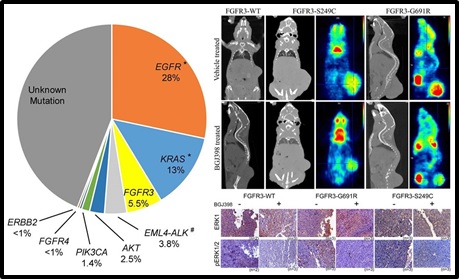
A novel therapeutic target in lung cancer
Clinical collaborator: Dr. Kumar Prabhash (TMH)Here, we present the first mutational landscape of actionable alterations and present the first systematic evidence that mutations of FGFR3 are present in 20 of 363 (5.5%) lung adenocarcinoma patients of Indian origin. Our study establishes that FGFR3 extracellular and kinase domain mutations found in lung adenocarcinoma patients are oncogenic and sensitive to small molecule inhibitors in vitro and in vivo systems, using mouse xenograft assays. Interestingly, the FGFR3 mutations appear to be significantly higher in proportion of patients less than 45 years (9 of 95) than in patients above 45 years (11 of 269) (P = 0.048). The Kaplan Meier curve analysis available for 205 of 363 patients suggests that compared to wild-type FGFR3 cases, patients with FGFR3 mutations show a trend towards better overall survival of 17 months (n= 8; 95% CI: 6.4-27.5; HR: 0.6; P= 0.5). These findings provide newer insights into driving oncogenic events in a subset of lung adeno-carcinoma cancers among patients of Indian origin, and implicates FGFR3 as a novel therapeutic target. Among the Caucasians, activating mutations in FGFR3 have been reported in bladder carcinoma, lung squamous cell carcinomas, and, cervical cancer, but were found to be largely absent in lung adenocarcinomas, except for Imielinski et al., who reported non recurrent somatic FGFR3 mutations of unknown functional significance in 3 of 183 lung adenocarcinoma patients (1). More recently, presence of frequent FGFR3 mutations has been tangentially referred to in the literature among Korean lung adenocarcinomas patients patients (2). Taken together, this suggests an emerging trend for a role FGFR3 mutations in lung adenocarcinoma, more likely to be predominant among the Asian population.

[Left panel represents a comprehensive spectrum of mutations (mostly druggable) in Indian lung cancer patients (n=363) that was previously unknown. Right upper panel: PET scan to show the novel FGFR3 mutation found in patients forms tumors in mice that responds to FGFR inhibitor; lower panel shows the drug is specific! ]
[natureINDIA]
[IndiaBioscience]
[wellcomedbt]
[Indian Express]
1. Imielinski M, et al. (2012) Mapping the Hallmarks of Lung Adenocarcinoma with Massively Parallel Sequencing. Cell 150(6):1107-1120.
Lim SM, et al. (2016) Targeted sequencing identifies genetic alterations that confer Primary resistance to EGFR tyrosine kinase inhibitor (Korean Lung Cancer Consortium). Oncotarget.